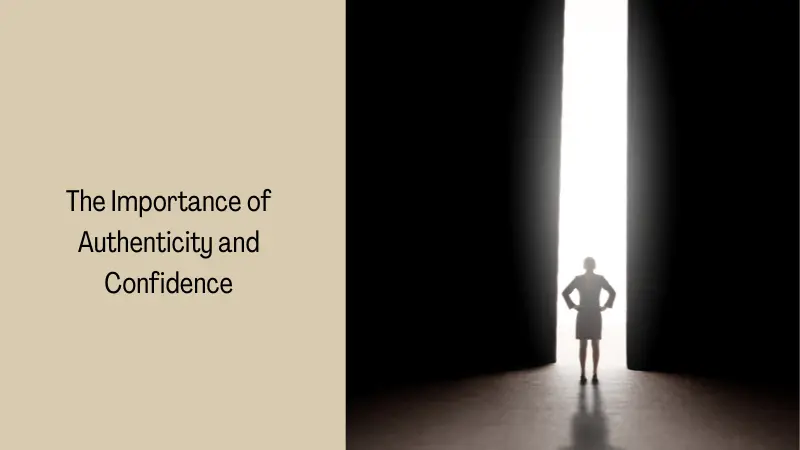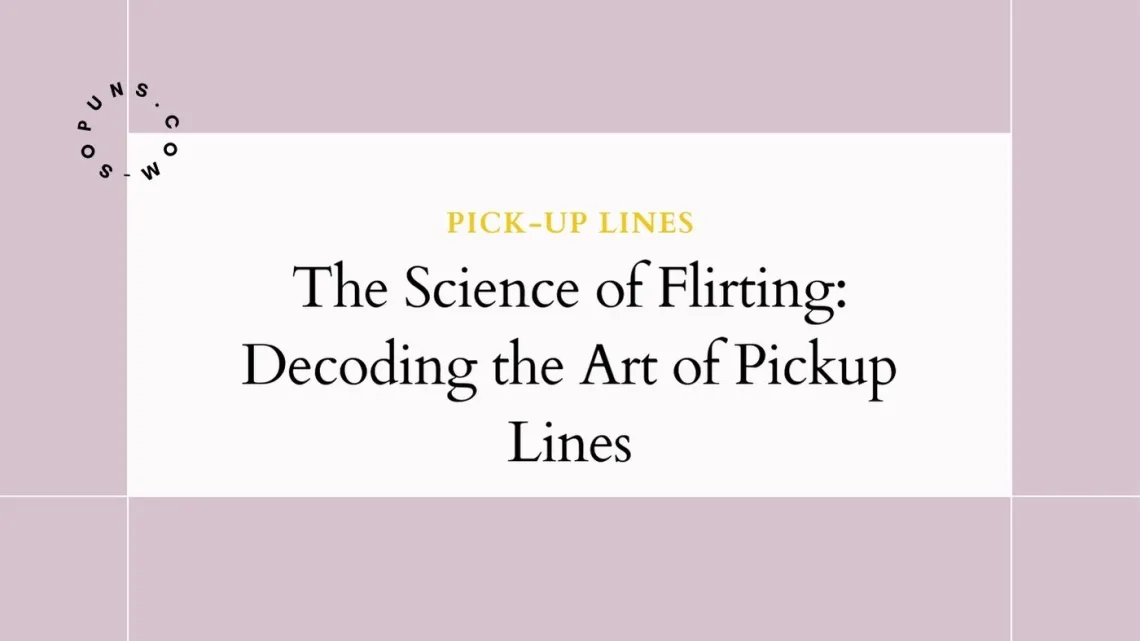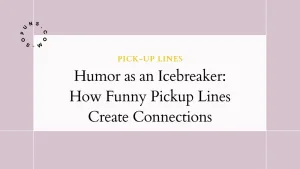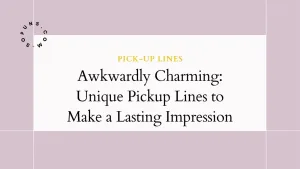Flirting is an age-old human ritual. For centuries, people have used playful banter and cheeky remarks to attract potential romantic partners. Pickup lines are often the chosen icebreakers to spark a flirty conversation. But what really makes a good pickup line? Is there a science behind these humorously suggestive phrases? This article dives into the psychology and strategy behind crafting effective pickup lines.
The Complex Psychology of Attraction and Humor
Physical attraction plays a big role in initial flirting. People are drawn to certain facial features, body types, style, and confidence. But it takes more than good looks to land a date. Successful flirting also leverages the power of the mind.

Humor is an intellectual tool that signals intelligence. Clever, funny pickup lines showcase creativity, wit, and quick thinking. Laughter releases endorphins that generate feelings of pleasure and emotional bonding. Amusing remarks also break the ice and make it easier to transition into real conversation.
Of course, sense of humor is subjective. So pickup lines are gambles that may make you look ingenious or completely lame. The key is understanding what makes someone laugh and what turns them off.
Pickup Lines as Conversational Icebreakers
Pickup lines are essentially conversation starters. Despite their sometimes outrageous nature, they serve a purpose – to catch someone’s attention and introduce yourself.
Cheesy one-liners advertise a flirty mindset and intention to get to know someone better. A funny remark indicates you’re confident and socially savvy enough to approach a stranger. It also gives the other person an easy opening to reciprocate or turn you down gently.
Pickup lines announce “I find you attractive and would like to talk.” Their humor and absurdity take pressure off the recipient to respond a certain way. And they allow both parties to brush it off gracefully if there’s no interest.
Factors that Make Pickup Lines Effective
According to researchers, key factors influence the success rate of pickup lines:
Delivery and Timing are Everything
Pickup lines depend largely on delivery, context, and nonverbal cues. Said with awkwardness or at the wrong moment, the best one-liner can still fall flat. Confidence and authenticity are key.
Wordplay and Humor Work Best
Playful, witty opening lines get better reception than direct comments on appearance. Wordplay and humor signal creativity.
Avoid Negging and Insults
“Negging” and backhanded compliments are ineffective. Genuine, positive remarks work best for making connections.
Adapt to the Situation
Pay attention to context clues. Is the setting appropriate? Is the other person open or busy? Tailor your approach accordingly.
Look for Common Ground
Finding shared interests, experiences, or attitudes builds rapport. It gives you something substantial to talk about.
Body Language Speaks Volumes in Flirting
Research shows nonverbal signals play a huge role in effective flirting. Positive body language and facial expressions reinforce a pickup line’s humor and authenticity.
Smiling and eye contact indicate friendliness and confidence. An animated speaking style captures attention. Open postures and leaning in ever so slightly say you’re engaged. Mirroring subtle mannerisms fosters an instinctive bond.
In contrast, crossed arms, fidgeting, and lack of eye contact broadcast anxiety or insincerity. Reading body cues is key to calibrating your approach and response.
Scientific Studies on Pickup Lines and Outcomes
Yes, social scientists have actually studied the use of pickup lines and their effectiveness! Here are some fascinating findings:
- Men are more likely to use pickup lines when flirting. Women tend to wait to be approached.
- Funny, clever opening lines are universally preferred over physical compliments.
- Self-deprecating humor works better than flattery for those with low self-esteem.
- Pickup lines are more effective on women when delivered by men who are older, extraverted, and physically attractive.
- For men, clever lines used by women are seen as most effective. Physical attractiveness of the woman also plays a role.
- culturally tailored opening lines work better than generic phrases. Shared background improves reception.
So the science indicates pickup lines are indeed an art that must be crafted to one’s strengths!
The Importance of Authenticity and Confidence
While humor and wordplay are great tools, authenticity is key. Forced, overly complicated remarks often fall flat. The most effective pickup lines align with the flirter’s true personality.
Owning your style with relaxed confidence also makes a difference. Say a corny line sincerely with genuine eye contact, and it can still charm. Delivery is everything.

A warm, confident demeanor says you’re comfortable in your own skin. This allows others to relax and enjoy the witty banter without feeling awkward.
Believe in your own wittiness and humor. This infectious confidence empowers you to use cheesy lines playfully and unabashedly. And that amusement and charm is what makes flirting work.
When to Use Pickup Lines…And When to Avoid Them
Pickup lines are great for grabbing attention and breaking the ice. But their entertainment value wears off quickly. The next step is pivoting the conversation toward getting to know each other authentically.
Avoid using one-liners as interview questions. Keep things light and let real rapport develop naturally. And know when to retire a pickup line so it doesn’t become distracting.
Also, read the room. In some contexts, avoid pick-up lines altogether. If someone seems preoccupied, irritated, or uninterested, scrap the canned remark. Stick to more polite greetings and see if they’re receptive to small talk before flirting.
Recovering Gracefully When a Line Falls Flat
Let’s be honest – even the wittiest pickup lines can flop. When a remark is clearly not working, the key is laughing it off with grace.
If your line elicits groans or blank stares, stay cool. Just say something like “Well that went over like a lead balloon! I’ll try better material next time.” And segue into a genuine, normal conversation.
Being able to brush off awkward moments shows maturity. Don’t let a lame one-liner phase your confidence.
Remember: effective flirting isn’t about witty lines – it’s about putting yourself out there with charisma. So own the situation and move forward. The right people will appreciate your ability to gracefully recover. And you’ll have a hilarious story to tell!
Frequently Asked Questions
Are pickup lines a good idea?
It depends! Used sparingly, funny, and clever lines can be great icebreakers. But rely on authentic conversation to make meaningful connections. Don’t let pickup lines dominate the interaction.
Do pickup lines actually work?
Sometimes! With confident delivery and receptive audiences, witty lines can charm and captivate. But they are gambles and won’t always work. So have backup topics ready just in case.
What is an example of a good pickup line?
Playful, thoughtful lines tuned to the setting tend to work best. Like at a bookstore: “I just started reading a book about anti-gravity. It’s impossible to put down!”
What should you not say when flirting?
Avoid tacky lines about physical appearance or sex. Negging insults are a no-no. Steer clear of off-color humor or creepy remarks.
Is it OK to use funny pickup lines?
Humor is great for flirting when used with sensitivity. Funny lines showcase wit and break the ice. Just avoid overly corny lines that try too hard – sincerity reads better.
In Summary
Mastering the art of flirting requires understanding the psychology behind attraction and humor. When delivered with authentic confidence, playful pickup lines can be great conversation starters. While canned one-liners have limited effectiveness, they add fun and lightness to making real romantic connections. Tune your flirting style to your strengths. And learn to laugh and recover gracefully when clever lines fall flat. Remember, being quick-witted is less important than putting yourself out there with charisma.






No Comments